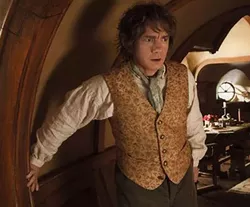The Hobbit | B
If there's one word that describes The Hobbit: An Unexpected Journey, it's "more." More action. More digital effects. More characters. More background exposition. More time in the Shire. More, more, more. And that's not a good thing.
There's a point at which it seems some directors can no longer be told no. With regard to the work of translating J.R.R. Tolkien to the screen, Peter Jackson appears to be in that position. Which is a shame, because buried beneath the bloated 2-hour-and-46-minute run time of The Hobbit is an entertaining two-hour movie. Jackson (along with New Line Cinema and MGM), however, has inexplicably decided to turn a 300-page children's book into three three-hour movies. Well, maybe given the box office returns on the Lord of the Rings movies, the decision isn't so inexplicable. But it is unfortunate.
Set 60 years before The Lord of the Rings, An Unexpected Journey follows Bilbo Baggins (Martin Freeman) as he's recruited by Gandalf the Grey (Ian McKellen) to join a company of 13 dwarfs, led by the Thorin Oakenshield (Richard Armitage), on their quest to reclaim the lost Dwarf Kingdom of Erebor from the fire-breathing Dragon Smaug. Middle Earth is greener and more peaceful than depicted in the Lord of the Rings trilogy, but that doesn't mean the journey lacks for danger. There are goblins, orcs, trolls, wolf-like wargs and even stone giants that send the merry band scurrying through dark forests, treacherous mountains and underground caves. And, of course, Gollum, the creature that forever changes both Bilbo and his nephew Frodo's lives.
Once the story is painstakingly (and somewhat tediously) set in motion, Bilbo's adventures fall into a rigid formula of dramatic peaks and valleys, very much mimicking the episodic cliffhanger structure of a bedtime story. The group travels to a new and strange location, picks up a tidbit of information (sometimes relevant to their journey, sometimes not), runs into peril, flees in an action-packed chase scene, is cornered by the enemy, then is miraculously rescued at the last moment (usually by Gandalf). Wash, rinse, repeat. Everything – the dialogue, the action sequences, the exposition — feels padded, as if Jackson is purposely stalling the dwarfs' quest in order to justify his next two sequels.
His chase-capture-escape plotting may be a tried and true (if overly simplistic) form of storytelling, but it never achieves the epic sweep, sense of wonder, or emotional investment of the LOTR films. For one, we've seen many of these places and creatures before, and though the digital effects work has greatly improved over the last decade, they no longer have the wow-factor that accompanied the original trilogy. It could even be argued that, like Lucas' Star Wars prequels, Jackson relies a bit too much on CGI, replacing tactile environments and actors in makeup with digital creations. Personally, I preferred seeing actors who played orcs rather than the effects — impressive as they may be — on display here.
More importantly, however, the stakes in The Hobbit simply aren't high enough. Helping a group of dwarfs win back their kingdom doesn't pack the same narrative punch as defeating the ultimate evil. As a result, Bilbo and his companions lack dramatic urgency. Whereas Frodo's journey involved a series of small missions in service of a larger goal — rallying the creatures of Middle Earth to fight against Sauron, the destruction of the one ring, An Unexpected Journey is just a bunch of stuff that happens on the road to Lonely Mountain.
The dwarfs themselves are similarly problematic. Aside from the brave but hot-headed Thorin Oakenshield, and maybe two or three others, it's a challenge to tell them apart. Few are granted any personality at all. Given that we're supposed to be invested in their fate over the course of three films (we already know what happens to Gandalf, Bilbo and Gollum), it's hard to muster much concern for a group of mostly anonymous characters (no matter how nicely they sing).
Despite all these shortcomings, The Hobbit will undoubtedly delight fantasy fans with its boisterous pell-mell pursuits, wild-slides through underground tunnels, and feverishly pitched battles. The 3-D is first-rate and, though many of the scenes go on too long, they are visually inventive and dramatically exciting. An encounter with a trio of hungry trolls is great fun, the realm of the Goblin King (an amazing creation) plays like a high-wire, rickety rollercoaster ride, and Thorin's nemesis, the albino-orc named Azog the Defiler, is an effectively nefarious foe.
Amid all this ruckus, the movie's best moment involves an underground lakeside battle of wits rather than blades. Separated from his companions, Bilbo must come into his own and outsmart the despicably loathsome yet ever pitiable Gollum (Andy Serkis) in a riddle-off. It's an interlude that reminds you just how important character development is, even in a noisy, raucous thrill-ride like The Hobbit.
For the die-hards there are plenty of cameos (Elrond, Galadriel, Saruman and Frodo all put in an appearance), dramatic connections to the events in the LOTR trilogy, and tangents taken from Tolkien's appendices. They should have been left for the Blu-ray extended edition.
Like Star Wars, the Twilight films and The Hunger Games, The Hobbit: An Unexpected Journey will inevitably prove to be critic-proof. There's a reason the novel has sold more than 100 million copies. Though the movie doesn't always seem to know what it wants to be (it awkwardly shifts between the lighter tone of the novel and the epic melodrama of the trilogy), it knows exactly who it was made for: anyone with $10 to spend and a hankering to return to Tolkien's land of elves, dwarfs, halflings and wizards.


